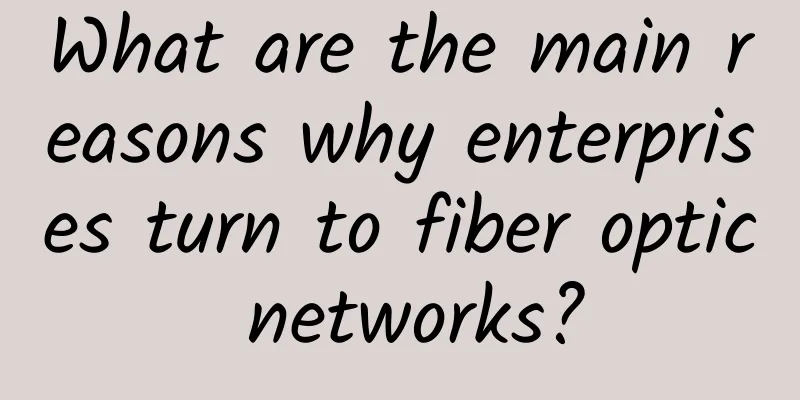What are the main reasons why enterprises turn to fiber optic networks?

|
The invention of fiber optic cables has revolutionized data transmission and helped Internet companies provide high-speed data. In addition, the reliability and performance provided by fiber optic cables are the main reasons why companies choose fiber optic cables. Reliability is keyInternet outages can be damaging to any business. Customers choose those ISPs that can provide reliable service and consistent performance. Copper cabling and outdated support systems for coaxial cables can hinder connectivity many times. Any outage on the Internet costs money, resulting in lost or reduced profits. Fiber optic cables will ensure continuous connectivity with infrequent interruptions. Each customer will have a dedicated line, reducing the possibility of interruptions and helping businesses provide the best service. In addition, copper cables can suffer from defects during harsh climatic conditions, including wind and rain. Moisture can affect data transmission, affecting business. It is not affected by climatic conditions and high temperatures. Therefore, entities with fiber optic networks have nothing to worry about in these situations. High-speed InternetIn this fast-paced world, everyone expects fast responses in all areas. Whether it is sending files over the internet, searching for things in the digital world, or researching a specific topic, everything requires a perfect rhythm. Since the function of fiber optic cables is based on optics or light, the data speed is also higher than other traditional cables. It can reach speeds of up to 100Gbps, although you may not need such high speeds at the moment. Cost-effective network solutionsFiber optic networks are more cost-effective compared to copper cables. If a business wants to increase the data transmission speed, it has to use a larger size of copper cables. Although the cables are a little more expensive than copper cables, the additional positive aspects make it advantageous to choose the same. Fiber optic networks are lightweight and thin, requiring only limited space. Made of non-corrosive materials, these thin cables are strong enough to withstand tensile stress if needed. In addition, an easy and fast installation process saves money and time. Fiber optics provide scalabilityFiber optic cable is scalable. The number of clients, service demands, and bandwidth requirements are likely to increase over time. The most important factor for fiber optic cable is that no additional infrastructure or equipment is required to meet the requirements. Consider the case of a DSL system or any other technology. Internet speed will decrease as the load or number of clients increases. Furthermore, even if additional equipment is installed, it will not provide speeds exceeding (approximately) 200Mbps. Furthermore, the fiber optic network does not require additional maintenance to prevent moisture ingress or additional monitoring in harsh climatic conditions. Providing high durability, the cable will function perfectly throughout the entire period without any problems. Safety and securitySecurity is the biggest concern of every entity. Businesses in the cyber world spend huge amounts of money to prevent intrusions and activities of criminals. Hackers and anti-social elements can take advantage of less secure copper cables to get into the system and extract data about the business. This is another area where fiber optic cables have the highest characteristics. Digging into optical fibers is more difficult and complicated than digging into copper and cables. Therefore, businesses operating in the cyber world are increasingly relying on optical fibers. Apart from the above reasons, broken or defective copper or wires can also cause fires. If not detected and replaced in time, it can cause more damage. Fiber optics are gaining popularity due to the advantages they offer. Businesses around the world that provide exclusive services to customers, Internet service providers, and other entities are switching to fiber optic cables. It has changed the data transmission scenario and made high-speed internet a norm. |
<<: Connecting the World: 5G and Beyond Technology Trends in 2024
Recommend
Gcore: Miami E5-2623v4 CPU dedicated server 25% off, supports Alipay
The blog has shared G-core (gcorelabs) products a...
Best Practices for Data Center Disaster Recovery
Today, data center operators worry about high ava...
Are operators “breaking away from” the old ways? 2G/3G networks will eventually leave the stage
Recently, China Telecom Yunnan Company (Yunnan Te...
Aruba SD-WAN and cloud security products are now available on AWS Marketplace (China), building secure edge-to-cloud connections
In the cloud-first era, the relationship between ...
The interviewer asked about the ZAB protocol right away, and I was trembling...
[[391275]] Zookeeper achieves the final consisten...
RhinoTech: Dedicated servers seckill + 20% off starting at $24.5, US/Japan/Korea data centers
RhinoTech sent an email yesterday about its Augus...
DogYun: Hong Kong VPS monthly payment starts from 15 yuan, Australia/Korea/US VPS monthly payment starts from 20 yuan
When it comes to low-priced VPS, we first think o...
[Christmas] DMIT: $100/year-2GB/40G SSD/2TB@2Gbps/Los Angeles CN2 GIA
DMIT has released two special Christmas packages,...
How cloud services enable a 5G-driven future
As high-speed cellular networks become mainstream...
618 is here, it’s time to upgrade your WiFi 6 router!
[[404856]] 618 is here, and during the annual sho...
China has opened nearly one million 5G base stations, and China Mobile is almost caught up
According to the latest data, the three major ope...
When Wi-Fi 6 enters the home, car and other industry markets, modules become the key players!
"What's the Wi-Fi password here?" I...
Huawei's Smart City Nervous System shines at CIIE
From August 21st to 23rd, the 2018 (4th) China Sm...
The three major telecom operators have begun to deploy 5G messaging on a large scale
5G messaging, which is seen by the industry as We...
PacificRack VPS is 50% off for a limited time, 8 cores, 16G memory, 61 IPs for only $50
PacificRack is now offering a promotion for Multi...




![[11.11] Megalayer: US server 99 yuan/month, Hong Kong server 199 yuan/month, Hong Kong/US VPS monthly payment 9.9 yuan](/upload/images/67cabd2ede72f.webp)




